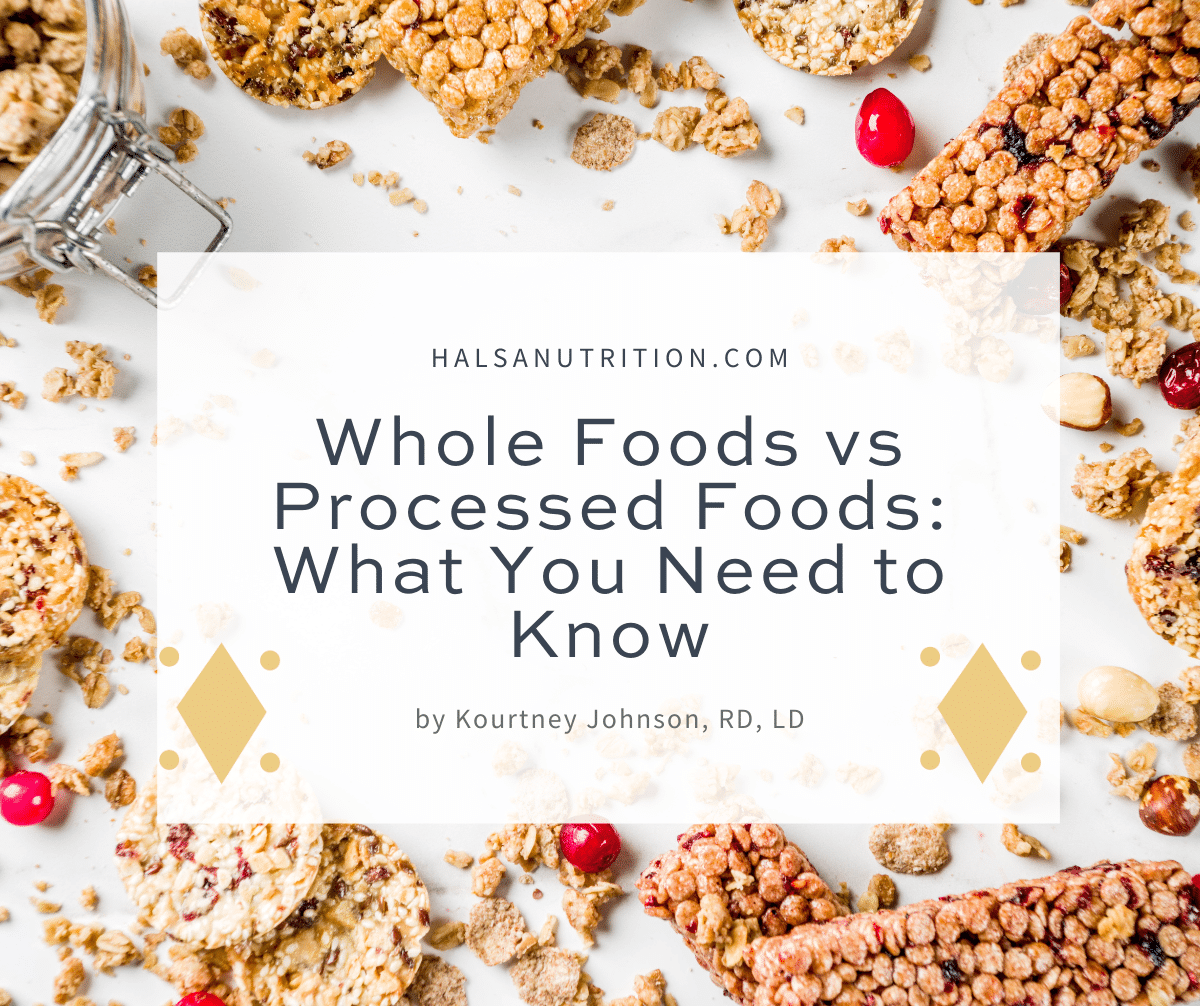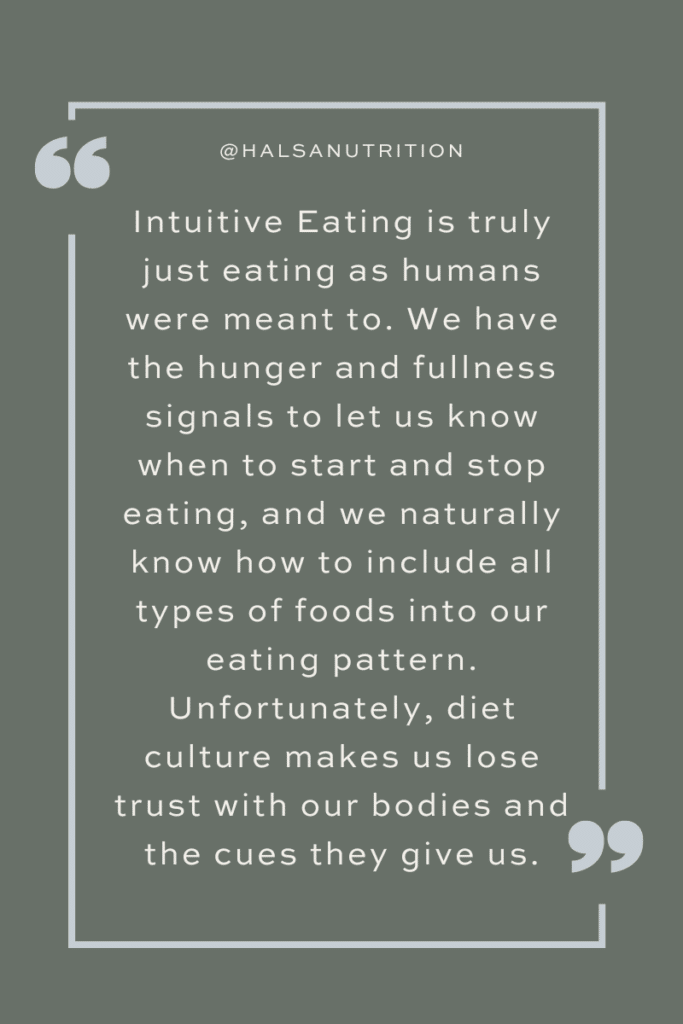
Whole Foods vs Processed Foods: What You Need to Know
Estimated reading time: 6 minutes
by Kourtney Johnson, RD
What comes to mind when you think about processed foods? If you’re like most people, you might think about the added ingredients in those foods, if those ingredients are healthy, or how to eat fewer of them.
Now think about whole foods. What comes to mind? Maybe pictures of fresh produce come up, or you think about how much healthier these foods seem to be.
There’s a big debate going on with whole foods vs processed foods. But what if I told you that processed foods can be part of a balanced, healthy eating pattern? That you don’t need to stress or fear these foods because they’re not inherently bad? Continue reading to find out the differences and truth behind these two polarized types of foods.
Whole foods vs processed foods: Differences between them
First, let’s go over what makes foods whole or processed.
If you search for the definition of whole foods, there are many different answers, ranging from foods that haven’t been processed to foods as close to their original state as possible. There isn’t a set definition for whole foods, which is why they vary.
Whole foods are often considered healthier than processed foods because they don’t have added ingredients like sugar or salt. They also don’t have additives such as vitamins or flavor enhancers. Fruits, vegetables, eggs, and meat are examples of whole foods.
On the other hand, according to the USDA, processed foods are those that have been changed from their original state. This includes being washed, cleaned, milled, frozen, dehydrated or packaged. Processed foods might also have added ingredients like preservatives or nutrients.
Foods considered “healthy” that are actually processed
Going by this definition, there are many foods that are processed which are also considered nutritious, or “healthy.” These include frozen fruits and vegetables, whole wheat bread, nuts, cereals, olive oil, and dried fruit.
We also often hear about the importance of choosing foods with few ingredients or only additives that we can pronounce. However, this isn’t a good rule to go by, because ingredients can be things like vitamins or emulsifiers.
Take cereal, for example. This is a processed food that has folic acid added, which helps avoid neural tube defects in around 1300 babies each year in the US, according to the CDC. Cereal can have iron added as well, which is a nutrient needed to avoid iron deficiency anemia. To make sure the cereal you eat is a good source of iron, each serving should contain at least 4 milligrams.

Emulsifiers are other ingredients added to processed foods. A common type of emulsifier is carrageenan, which is derived from red seaweed. Carrageenan is often added to products like nut and soy milk, yogurt, protein powder, and ice cream. It helps create a satisfying texture, mix all ingredients, and protect the nutritional value of different foods without giving up good flavor.
What about ultra-processed foods?
Ultra-processed foods are those that have been changed more drastically than ones like milk or frozen fruits and veggies. Examples include soda, packaged soups, frozen meals, and hot dogs.
In the ongoing debate between whole foods vs processed foods, many suggest avoiding ultra-processed foods altogether. However, this is unrealistic and unnecessary. The idea with Intuitive Eating is to include a variety of foods and to make peace with all foods so everything is seen as neutral. This means no one food has power over others, removing the need to eliminate foods out of fear.
Keep in mind that Intuitive Eating is not “eat whatever, whenever.” When you go through the process of becoming an intuitive eater, you will get to the point where you want all foods, and ultra-processed ones won’t seem as exciting once they aren’t forbidden. You’ll be able to include all foods, even those seen as “unhealthy” in a balanced way once you’ve healed your relationship with food.
Does it sound too good to be true?
At first, Intuitive Eating might sound too good to be true. Is it really possible to find a balance and not have the mindset of “whole foods vs processed foods” where your mind says you need to stick to the “healthier” options but your heart and taste buds want chips?
Actually, Intuitive Eating is truly just eating as humans were meant to. We have the hunger and fullness signals to let us know when to start and stop eating, and we naturally know how to include all types of foods into our eating pattern. Unfortunately, diet culture makes us lose trust with our bodies and the cues they give us.
This is why working with a registered dietitian trained in intuitive eating can help. They can guide you through the process of becoming an intuitive eater while holding space for you and the questions, doubts, and fears that might come up.
You can develop a healthy relationship with food and your body. It’s possible to get rid of the worries you may have, such as “whole foods vs processed foods”. And this shift in mindset will help you start living more freely.
Where to Get Help
- Nutrition counseling with Maria, owner of HalsaNutrition.com
- Directory of Certified Intuitive Eating Counselors
Other Posts You Might Enjoy
About the Author
Kourtney is a registered dietitian who is passionate about sharing information related to intuitive eating and the harms of diet culture. She is from Minnesota but now lives in Spain, where she enjoys trying new foods and learning more about the culture there! In her free time, she likes to read, go to the beach, spend time with friends and family, and travel.
This article was edited and reviewed by Maria Adams, MS, MPH, RDN, LDN, a registered dietitian and Certified Intuitive Eating Counselor. Maria takes a weight-inclusive approach and helps individuals rediscover the joy of food and eat to feel their best by healing from chronic dieting and disordered eating. She holds a Bachelor of Science Degree in Nutrition Science, a Master of Science in Nutrition Communication, and a Master of Public Health.

Leave a Reply